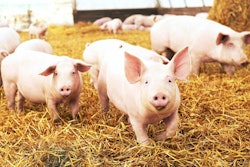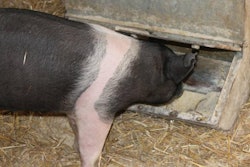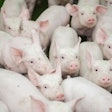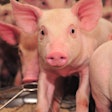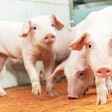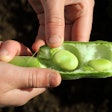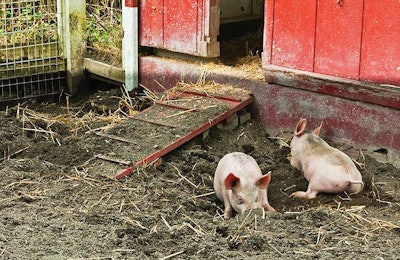
Iron (Fe) is the most abundant trace mineral in the body. Although its nutritional value has been known for over 2,500 years, its role has only recently been truly appreciated in both human and animal nutrition. Iron is an integral part of hemoglobin and myoglobin, both of which play a central role in the exchange of oxygen and carbon dioxide between blood and muscles. Iron also plays an important role in the function of many enzymes, including those in the Krebs Cycle, the major cascade of reactions that “fire” the energy metabolism in the body of animals. As such, the role of iron in the organism can only be described as indispensable.
Deficiency
Yet, despite this obviously tremendous importance placed on iron, sow’s milk is exceptionally poor in iron (about 1 mg/liter). This appears like a paradox, especially if one considers that piglets are born with very low levels of iron reserves (less than 50 mg in total). If we accept a daily requirement of 10 mg iron, it is evident that piglets are certain to develop iron deficiency (anemia) within the first week of life if their only source of iron is sow’s milk. Could this be a “failure in design”?
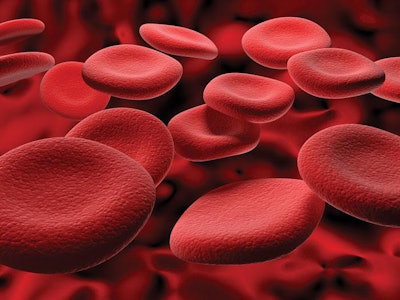
Iron deficiency (anemia) impairs the function of red blood cells, effectively impeding the exchange of oxygen and carbon dioxide between blood and muscles, resulting in the common symptom of weakness. | Studio29ro, Dreamstime.com
Despite this apparent anomaly, piglets born in natural environments (for example, wild boar piglets or piglets born in outdoors systems) do not develop anemia. This is because they are in constant contact with soil, which is very rich in iron. Iron ingested as dirt via natural rooting or by suckling through a soiled udder is apparently more than enough to cover the needs of newborn pigs. Thus, it is believed the natural abundance of iron in the pig’s environment has reduced pressure during evolution for the presence of this mineral in adequate amounts in sow’s milk. This apparent anomaly can be described better as natural economy.
In contrast, piglets raised indoors are prone to develop anemia as they lack access to soil, and most frequently, only limited access to sow’s feces, which contain high levels of iron. Thus, anemia is a systemic problem of modern pig production, and it must be addressed properly. By any means, it is not a disease, although anemia due to infections can also occur, but this is beyond the scope of this review.
Anemia
Pigs develop anemia within the first couple weeks of life, resulting in high mortality rate if left untreated. Anemic pigs appear pale (white) in color. Their hair is rough and the skin is wrinkled. Their growth is severely impaired, and they frequently develop diarrhea as iron deficiency makes them less resistant to diseases. Severe anemia results in heavy breathing, fatigue, lethargy and may lead to pneumonia, and the characteristic "thumping" noise when breathing is due to fluids in the lungs. Post-mortem examination of anemic pigs reveals a dilated heart with excess pericardial fluid. Furthermore, the lungs appear edematous.
Read more: Why producers should monitor iron levels in animal feed
The assessment of iron deficiency (or the success of its treatment) is done by measuring blood hemoglobin and/or blood hematocrit (packed cell volume, PCV). Normal hemoglobin values are between 110 and 120 g/liter, but numbers may be highly variable (85 to 135 g/liter). It is suggested values less than 25 percent of normal should be considered as risk of anemia, whereas below 50 percent should be classified clearly as severe anemia.
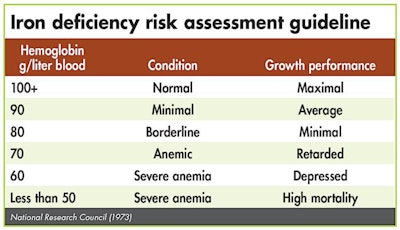
Values less than 25 percent of normal should be considered as risk, and values below 50 percent should be classified clearly as severe anemia.
Old treatments
The most obvious treatment to piglet anemia has been to provide them access to soil. In modern facilities, this translates to providing soil in the farrowing crates in small containers, or the typical lock-down feeders (usually found as a red round plastic plate) used for providing creep feed. This method has several problems, the least of which is a variable intake of soil and thus non-uniform treatment of anemia. Furthermore, it is labor intensive, requiring daily replenishing of soil. Worst of all is the problem of parasites and diseases that can be transferred through the soil to piglets, something that can be partially alleviated by sterilization of the soil, but to the detriment of increasing the cost of treatment. This method is now followed by few, if any, smaller farms.
Preventive treatment is essential to avoid reduced growth, further complications with secondary diseases and high mortality.
Another method of providing iron to newborn piglets has been covering the sow’s udder with a semi-fluid paste of ferrous salt. This is created by mixing 1 kg of a soluble iron salt (such as ferrous sulfate) with 2 liters of hot water. The ensuing mix is rubbed daily on the sow’s udder using a large brush or cloth swab. Again, this is a very labor intensive procedure requiring attention to ensure sufficient coverage of the udder. This method is used only infrequently and only when other more modern methods are not available or not desired.
Modern treatments
Modern methods for treating piglet anemia can be classified as those administering iron via the oral route or via intramuscular injections. Each method has its benefits and drawbacks.
- Creep feed. Providing high levels of iron through creep feed is not recommended because piglets usually do not consume enough creep feed early enough to prevent anemia. In addition, some piglets might consume excess feed, resulting in iron oversupply that can lead to colibacillosis and diarrhea. Clearly this is not a recommended method, although it is frequently advertised as such.
- Rooting material. Providing sterilized turf or preserved silage, with or without supplemental iron, is a method that has been tried with some success. It is laborious and requires diligence in application and hygiene, without providing uniform coverage of piglet iron needs early in life. Thus, many piglets remain anemic or borderline anemic, requiring further treatment. This method can be part of a more broad treatment protocol involving other supplemental sources of iron, such as iron-rich pastes or tablets.
- Paste. This is a relatively recent development in which an iron-rich paste is placed into the mouth of newborn piglets (usually within a couple days from birth). This paste is most likely to contain energy sources (glucose and lipids), immunoglobulins, vitamins and other minerals. For this method to succeed, the form of iron must be such that is readily available for digestion by the piglet. This method of preventing iron deficiency is gaining popularity as it offers a less invasive alternative to intramuscular injections.
- Oral Tablets. Another innovative way to provide iron in the form of a small tablet placed at the root of the tongue causing a natural swallowing reflex. Again, the iron must be provided in a highly digestible format. It is important to have a trained person perform this task; otherwise rejection of the tablet will be high resulting in extra handling of the piglet (to administer a second tablet) and increased expense.
- Intramuscular injection. This is the most common method for preventing piglet anemia. In brief, piglets are injected in the muscle of the neck (preferred) or ham with 100 to 200 mg iron, as iron dextran (most common form but not the only one), during the first two days of life. Assuming pigs are weaned about 21 days of age, this dosage provides enough iron to cover their needs until they start consuming enough dry feed post-weaning. If weaning age is later than 21 days of age, then a supplementary dose may be required, but this is best assessed on a farm-by-farm basis by the attending nutritionist or veterinarian as it depends on the use of creep feed. The most common problem with injections is that they must be done by experienced personnel to avoid animal discomfort, ensure proper administration of the complete dose at the appropriate site and to minimize the risk of broken needles left inside the muscle. The latter problem condemns a large part of the animal (usually as valuable as the ham) or even the whole animal if efforts to retrieve the broken part are unsuccessful.
It's a management issue
Piglet anemia is not a disease but rather a management issue due to modern practices in raising pigs at indoor commercial facilities. Preventive treatment is essential to avoid reduced growth, further complications with secondary diseases and high mortality. The easiest way to provide iron to newborn piglets is by intramuscular injections, followed by more recent developments involving oral application of an iron-rich paste or tablet. All methods have positive and negative aspects, and these are best assessed and discussed with a qualified person, such as a veterinarian or nutritionist.



